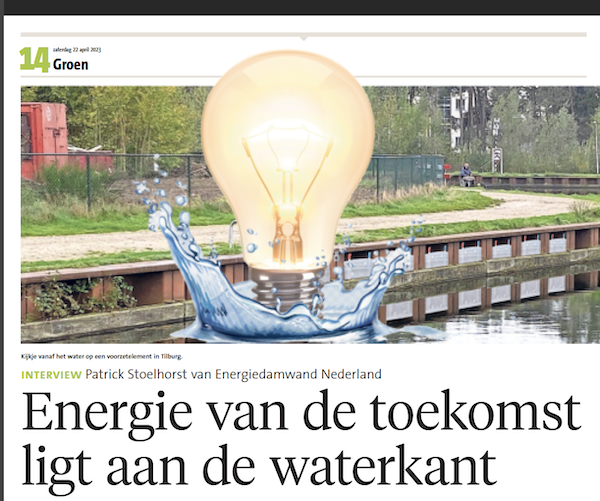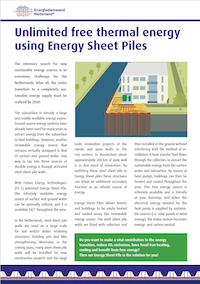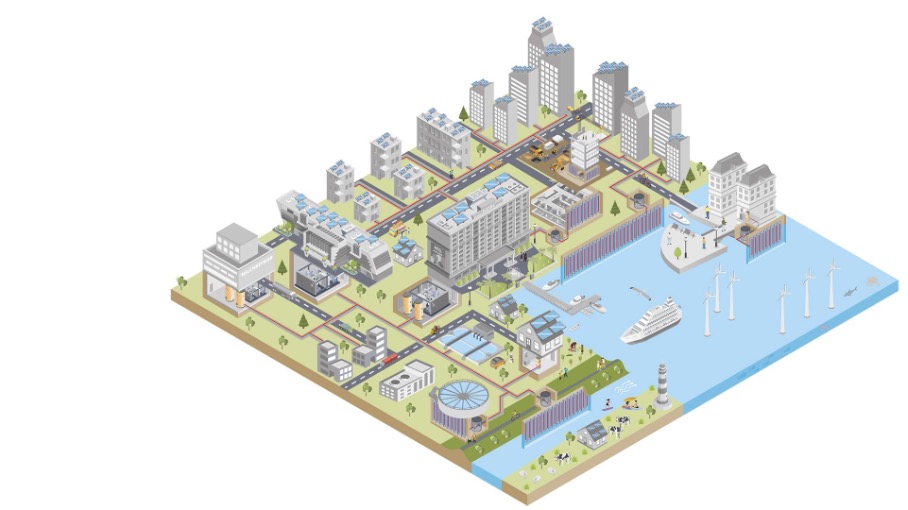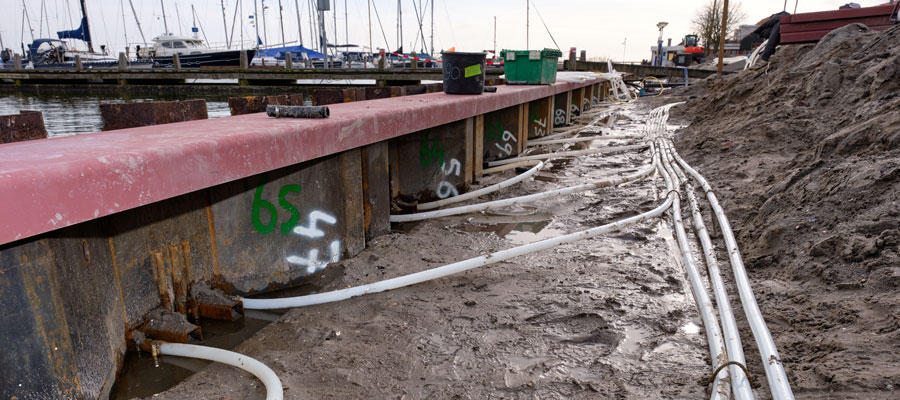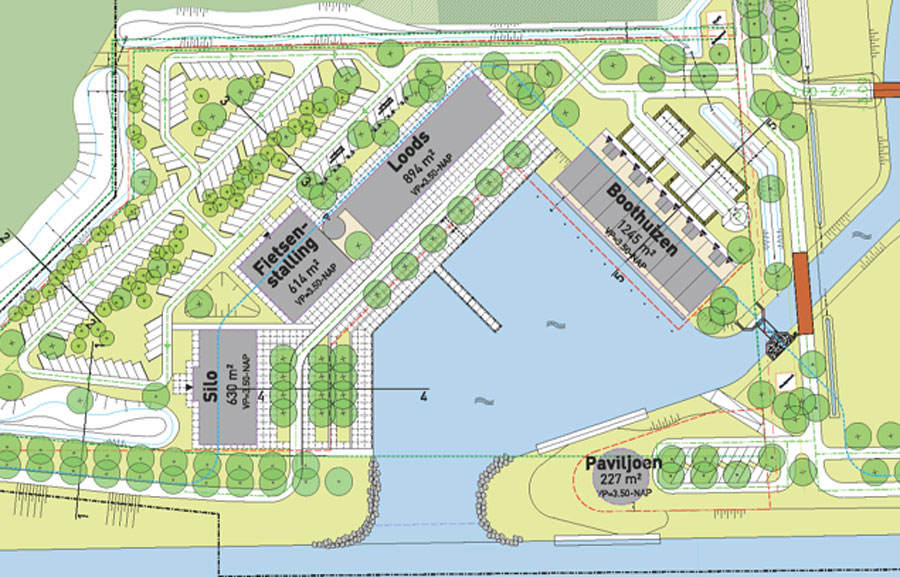Interview with Patrick Stoelhorst from Energiedamwand Nederlands
The energy of the future? It’s right in front of your door! Or, more accurately, by the many watersides that our low-lying country is blessed with. “You can source around 40% of our energy needs from surface water,” says Patrick Stoelhorst (57) of Energiedamwand Nederland. How? By equipping the sheet piles along the water with a pipe system.
You can find them everywhere in the Netherlands: steel sheet piles, large steel structures to contain water and hold the ground in place. Stoelhorst’s company, Gooimeer, based in Almere, specializes in the rental, sale and repurchase of steel sheet pile profiles. “It’s a true family business, founded by my father 47 years ago, and I have been working here for 31 years,” he explains. Gooimeer is one of the partners in the Energiedamwand Nederland consortium, which is further developing the energy-supplying quay wall. The technology of heat exchangers is not new: it has been around for about 40 years but has never been combined with sheet piles before. “About twelve years ago, Torsten Semmling, a German inventor, approached us with that idea. The energy transition was not a major concern at that time, and we didn’t know what to do with it.” However, Gooimeer closely followed all developments, while the University of Aachen continued to advance the technology.
Demo Model
“In 2019, we set up a demo model at our booth at InfraTech Rotterdam and simply observed how people reacted.” InfraTech Rotterdam is a major exhibition for construction projects related to road and water engineering, and the idea was very well received there. Gooimeer decided to join forces with CRUX Engineering, an independent consultancy specializing in geotechnics, geohydrology and soil. Together, they established Energiedamwand Nederland, obtained a license for the Benelux and initiated an initial pilot in Buurtschap De Zweth, in collaboration with the Technical Universities of Delft and Eindhoven and the Sustainable Energy Group (Groep Duurzaam Opgewekt). The location is near the Technical University of Delft. “Just a few houses, right by the water, where we could drive some sheet piles into the ground and collect data.”
The system consists of loops of pipes attached to the backside of the sheet pile (the waterside). Water with antifreeze runs through the loops, which is “heated” by the water on the other side of the barrier. “A steel wall conducts water heat very effectively,” Stoelhorst explains. The pipes are connected to an underground hose system that runs all the way to the house or building. The building can be a maximum of a few hundred meters from the waterside. Inside the building, the hoses are connected to a heat pump that uses compression to make the heat suitable for heating or hot water. Such a pump uses electricity, just like a heat pump driven by heat from the air or the ground. “You can also use it for cooling in the summer, You don’t have to drill deep into the ground, compared to, for example, geothermal energy, which requires drilling up to 1500 to 3000 meters deep. We go down a maximum of 25 meters,” he explains.
Closed System
“When the pump has extracted heat from the water, it flows back to the sheet piles and collects the free heated again.” It’s a fully closed system; the water with antifreeze in the pipes does not come into contact with groundwater or soil. Other advantages include the fact that it doesn’t disturb the ground, as the sheet piles are vibrated or pressed into places, it has no impact on soil layers or groundwater aquifer and it can be added to new quay walls at a modest additional cost. Another significant advantage is that is doesn’t create ‘landscape or horizon pollution’ like wind turbines and solar panels. However, they need to pay attention to some details. “You need to make sure that, if space is limited, the sewerage, electrical cables, and other underground pipes have enough space.” Furthermore, it’s a quiet system, according to the director. The two-year pilot in Buurtschap De Zweth involved extensive research. “We looked into how closely the pipes should run side by side, the influence of soil types, such as sand or peat, the depth of (ground) water and its temperature, how deep the wall goes into the ground, and whether we need to equip all meters of the system when installing a hundred meters of wall,” he enumerates. Of course, the yields were also evaluated. “When it was very cold in February 2021, the groundwater and the ground at a depth of fifteen meters were still between ten and fifteen degrees Celcius, and we could use that for heating. This would never be possible with an air heat pump,” he says with pride.
Fifty years ahead
Through five new pilots, partly financed by European Union subsidies, they will collect more data. These studies aim to make their models more accurate and to map the influence of saltwater and tides on the system. The more data they have, the better their models. “You can then calculate precisely how much the system will produce under those different conditions and in different seasons. We can project those measurements over thirty to fifty years.” A sheet pile lasts a hundred years, but fifty years is enough. “What our energy sources will be by then is still unknown.” The Energy Sheet Pile has already been used in the renovation of the marina in Enkhuizen and in the control building Swettehûs in Leeuwarden. In addition, they are testing a system on the pilot sites that can be applied to the outside of existing sheet piles.
Amsterdam Quaysides
The potential is enormous. Think of the quaysides along the river the Eem and the Waal and the lake the Oosterschelde and Ijsselmeer, but also water-rich cities like Amsterdam or Haarlem. Amsterdam alone has about 600 kilometers of quay constructions, of which 200 kilometers need renovation, according to Stoelhorst. When replacing stone quay walls with steel, he explains, “behind those stones, there is usually already a steel wall. The fact that the canal houses are not yet connected to the district heating network is also not a problem. They have to be in twenty years, and then you will already be prepared.” Because installing it later is always more expensive. “Five years ago, we supplied the sheet piles for the Blaricum new residential area Blaricummermeent. Almost eleven hundred home were built there. Suppose we had this product back then? Many homes could now ‘freely’ extract energy from the water that flows through that neighborhood.”
Missionary Work
You have to know that these new technologies exists, Stoelhorst emphasizes. Especially the parties involved in the energy transition: architects, developers, construction companies, energy suppliers, and the government, are all stakeholders in the consortium. “In the past, we only joined the discussion three months before the start of a construction project: now we sit down with these parties years in advance. But making it known everywhere is like missionary work.”
The beauty for the entrepreneur: “Steel has a polluting name, so how wonderful is it that you offset the CO2 emissions within three to four years with this system!” He says he only has a few hours in the day for all the new tasks, but it doesn’t matter because he certainly gains energy from it.
Greenchoice Energy Prize
The market recognizes the added value: Energiedamwand Nederland won the NENnovation Award 202, the Water Innovation Prize 2021, The Innovative Energy Solution Award 2022, and in the same year, the Greenchoice Energy Prize.

